Note: If an image ever fails to appear - refresh your page, it really is there
Flags of the Early North American Colonies and Explorers
| Top of Page | The Vikings | The Spanish | The Dutch | The Swedes | The English | The French | The Russians |
The Viking Explorers and Colonies
| Top of Page | The Vikings | The Spanish | The Dutch | The Swedes | The English | The French | The Russians |
The Spanish Explorers and Colonies
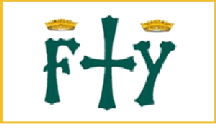
Captain's Ensign
|
Captain's Ensign of the Columbus Expedition 1492
This was the expeditionary flag for Admiral Christopher Columbus's historic voyage of discovery in 1492. This was not his personal flag as is sometimes suggested. The letter "F" was for King Ferdinand (Fernando) and the "Y" is for Queen Isabella (Ysabel). Strangely enough the usual English translation for Queen Ysabel is Isabella, which is neither proper English nor Spanish. The English translation for her name would be "Elizabeth." This ensign was flown by all three of the captains of his famous ships, the Pinta, the Nina, and the Santa Maria.
|

Royal Standard of
Castile and Aragon
1230-1516

Royal Standard of the
Catholic Kings
1492
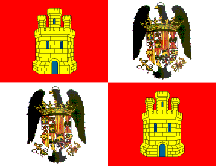
Is this the Royal Standard used by Columbus in 1492?
|
The Royal Standards of Spain in 1492
According to Christopher Columbus' logbook, he took the "Royal Flag," and two of his "Captain's Flags" when he landed on San Salvador (Watling's Island) in the Bahamas on October 12, 1492, to claim the newly discovered lands for his sponsors Isabella I of Castile and Ferdinand II of Aragon. These three flags became the first European flags to fly over the Americas if you discount the possibility of a Viking banner. The tradition claims the Royal Flag was quartered in red and white squares representing a Spain newly united under the "lions" of the royal house of Aragon and the "castles" of Castile. But which Royal flag remains a question?
Shown to the left are three possibilities. Strictly speaking, Columbus travelled only on behalf of Elizabeth, Queen of Castile and Leon; King Ferdinand ruled Aragon and Sicily. Castile and Leon had their own Royal Standard (shown on top left). However, the Catholic Kings of Spain had a different Royal Standard (shown at center left) and placing theirs in the second and forth quarters as suggested by some gives us a different flag for Columbus (shown at bottom left) for the trip. Which one is correct? ( Click here for an interesting discussion of this on FOTW )
In the United States Capitol Rotunda (Washington, D.C.), an 1846 painting by John Vanderlyn depicts the landing showing the castles and lions on a smaller shield centered on a golden field. He also depicts the Captain's Flags with golden fields, so perhaps the golden color only represented the reflection of the golden sunset on the flags white fields. (see Photo Gallery #1)
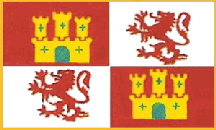 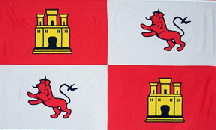
There is no shortage of modern versions of the Royal Standard of Spain available
( and the lions and castles seem quite fluid)
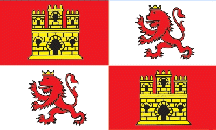 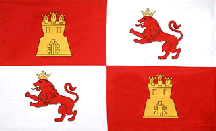
|
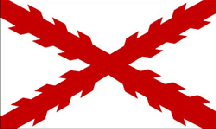
Cross of Burgundy
|
Cross of Burgundy 1506-1701
The Cross of Burgundy Flag was used by Spain as a naval ensign, and up to 1843 as a war flag on land. The banner dates back to the early 15th century when the Duke of Burgundy, as a claimant to the French throne, backed up the English in the Hundred Years War. When King Charles I ascended the throne, he adopted this flag in honor of his father Philip, the Duke of Burgundy. This is the flag carried by the conquistadors in their conquest of the Americas.
|
| Top of Page | The Vikings | The Spanish | The Dutch | The Swedes | The English | The French | The Russians |
The Dutch Explorers and Colonies
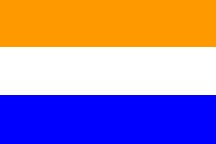
First Dutch Tricolor Flag 1572
(orange stripe)
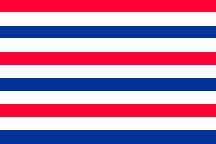
Dutch Triple Prince Flag 1596
(11 stripes - red stripe)
|
Dutch "Triple PrinceFlag" 1572-present
The Dutch tricolour was first used in the second half of the 16th century when the Dutch provinces revolted against Spain. Their leader was Prince William of Orange. The flag was named the "Prinsenvlag" ("Princeflag") after him. It was used as the naval ensign for Dutch ships and was the nearest thing to a national flag that the Dutch had when exploring North America. It was not uncommon to have versions of this Dutch tricolored flag (either orange-white-blue or later red-white-blue) with twice the stripes (double Princeflag - 6 stripes) or even three times the stripes (triple Princeflag - 9 stripes) on Dutch ships. Sometimes extra white stripes were added making 7 and 11 stripes on some versions.
In 1572 the orange-white-blue flag was first mentioned when the town of Den Briel was liberated. The red-white-blue flag was first mentioned in 1596. After 1660 the version with the orange stripe became very rare. It's still unknown why the orange stripe was changed, but one theory suggest simply that a new method of producing orange paint resulted in a darker shade, almost red.
The colors on the tricolor were never made official until 1937 when Queen Wilhelmina declared that "the colours of the flag of the Kingdom of the Netherlands are red, white and blue." In 1958, the colors were defined more precisely as bright vermilion and cobalt blue. |
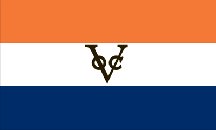
United East Indies Company
(original colors)
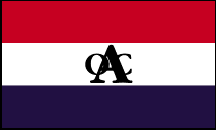
General East Indies Company
(revised colors)
Most likely caused when the original center stripe was inadvertently sewn on upside down.
|
Dutch (United) East Indies Company 1602-1798
The traditional story tells us that Henry Hudson sailed up the Hudson River in 1609, and purchased the Island of Manhattan for a handful of beads. Although Hudson did sail up the river, it is more likely that the legendary purchase of Manhattan from Native Americans took place 17 years later when Peter Minuit, the Director-General of New Netherland, did so for some trade goods valued at 60 guilders in 1626. Both men did work for the Dutch East Indies Company and use versions of this company flag. The tricolored flag used the Dutch national colors (see above) and had a large "V" and smaller "O" and "C" standing for the "Vereenigde Oostindische Compagnie" (VOC) or United East India Company. It was called "united" because it was actually six local companies, each based in a different Dutch city (Amsterdam, Delft, Enkhuizen, Hoorn, Middelburg, and Rotterdam).
Other modern variants of this flag (and there are many) show the "V" reversed as an "A" standing for "Algemeene Oostindische Compagnie" or General East India Company. Some claim the "A" stood for "Amsterdam," but although various chambers had their own local flags for the company, the city initials in reality never replaced the "V." ( Click Here for more information )
The Dutch foothold of New Amsterdam in North America, originally founded in 1625 by Minuit, would be lost to the English in 1664 during the Second Anglo-Dutch War, retaken from the English during the third Anglo-Dutch War, but then ceded back to the English as part of the Treaty of Westminster (1674) at the war's end. New Amsterdam was eventually renamed New York by the English to honor the Duke of York (later King James II). After this time, although no longer playing a key part in North American colonization, the Dutch East Indies Company continued to control Dutch colonies in Asia until 1800.
Hudson's last voyage of discovery was financed by a British company. The Honorable East India Company (see flag below) wanted to find the "North West Passage" over the top of North America to the Indies. On the voyage Henry Hudson, was cast ashore to die by his mutinous crew in the bay which now bears his name. |
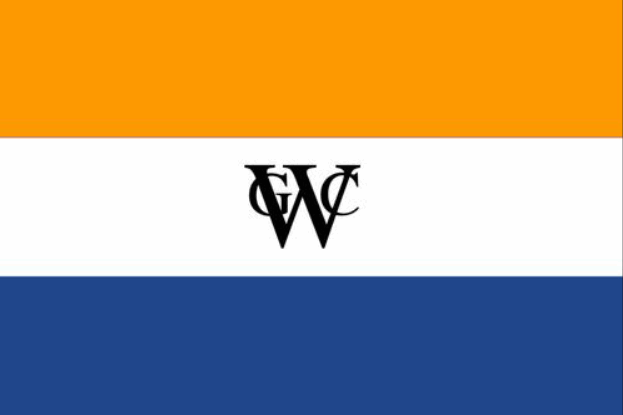
West Indies Company (WIC)
(original colors 1572)
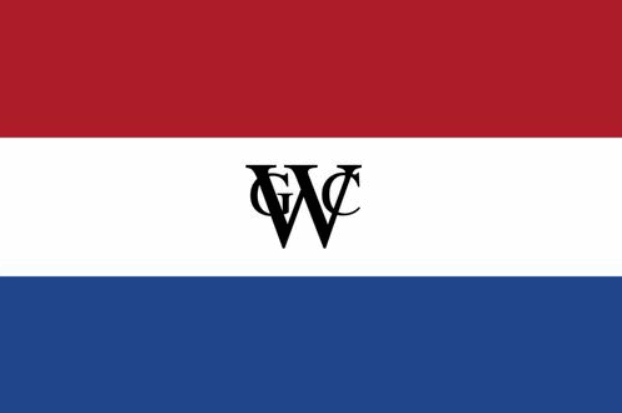
West Indies Company (WIC)
(variant 1596)
|
Dutch West India Company 1621-1674
When the Dutch East India Company (VOC) was founded in 1602, some traders in Amsterdam were unhappy with being left out of the trade monopoly. These Dutch merchants were allowed to organize a competing organization called the Chartered West India Company (Geoctroyeerde Westindische Compagnie) in 1621. They were granted a new trade monopoly in the West Indies and given jurisdiction over the Atlantic slave trade, Brazil, the Caribbean, and North America.
The WIC was organized similarly to the Dutch East India Company: it had five offices, or chambers (kamers), in Amsterdam, Rotterdam, Hoorn, Middelburg and Groningen; of which the chambers in Amsterdam and Middelburg were the largest. But unlike the VOC, WIC had no right to deploy military troops, so they turned to privateering. The arming of merchant ships with guns and soldiers (normally 40-50) to "defend" themselves, soon led to the hijacking of enemy ships. In 1628, a Dutch "merchant" ship, under the command of Captain Piet Heyn, seized a Spanish galleon which was on its way to Spain carrying all the silver mined in the Spanish colonies for the entire year.
The company was initially relatively successful and established trading posts and colonies both in Africa and the Americas. In the Americas, fur (North America) and sugar (South America) were the most important trade goods, while African settlements provided slaves destined for plantations, gold and ivory. In 1630, the colony of New Holland was founded, taking control over Portuguese possessions in Brazil.
Unfortunately for the WIC the Anglo-Dutch Wars and English victories, soon doomed the company. The original WIC went bankrupt in 1674, and a Second Chartered West India Company, or the New West India Company (chartered 1675), proved incapable of defending its colonies. In 1791, the second company's stock was bought by the Dutch government and all territories held by both companies reverted to the rule of the States General of the Dutch Republic. |
| Top of Page | The Vikings | The Spanish | The Dutch | The Swedes | The English | The French | The Russians |
The Swedish Explorers and New Sweden
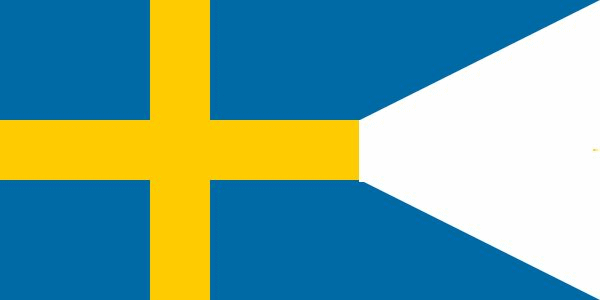
The Swedish Naval Ensign
|
Colony of New Sweden 1638-1655
In 1638, after a 4-month voyage from Sweden, two Swiss ships sailing for the Swedish West India Company, under the command of Peter Minuit, who later became the first Governor, sailed into Delaware Bay to start what became the Colony of New Sweden next to the southern Delaware River, actually in territory already claimed by the Dutch. They built a fort named Fort Christina, after Queen Christina of Sweden, at the site of the present day city of Wilmington and left 24 men, under the command of Lieutenant Mĺns Kling, to man the fort and trade with Indians. The expedition, sponsored by the Swedish West India Company, was the first of 11 expeditions (14 voyages) to the Delaware area between 1638 and 1655.
The Swedish Naval ensign flew over the Colony of New Sweden during this time. Since the flags used in the colony were obtained from the ships that brought the almost 600 settlers of the colony during the next 15 years, the naval ensign was a natural choice. This two-tailed flag would fly over the colony until its loss to the Dutch in 1655, when naturally the Dutch flag was raised to replace it. Some illustrations of the New Sweden Colony incorrectly show the more modern three-tailed Swedish flag (with the horizontal yellow bar extended and made into a tail) as the flag used by the colony, but this is incorrect. The British flag would then replace the Dutch flag in 1664 when the English captured the New Sweden Colony from the Dutch. |
| Top of Page | The Vikings | The Spanish | The Dutch | The Swedes | The English | The French | The Russians |
The English Explorers and Colonies
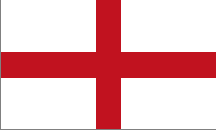
Cross of St. George
|
Cross of Saint George 1277
This flag was in use in England since the Crusades and it was one of the national emblems of England as early as 1277. Sir Walter Raleigh and Sir Francis Drake flew this flag while exploring the New World. It has been the English national flag for almost 900 years, and is still considered the legal national flag today.
Although the flag may have been used on ships that anchored near Jamestown, there is no evidence that this flag, or any other flag, was used on shore in Jamestown. The first reference to flags flying in Virginia were dated much later, long after the abandonment of Jamestown. Both flags are displayed today at the reconstructed fort at Jamestown. |
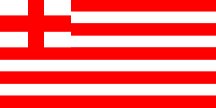
English East India Company 1678
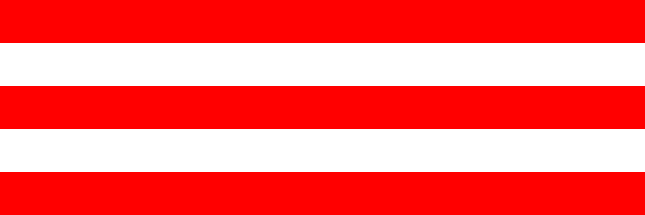
EEIC Streamer/Pennant
17th Century
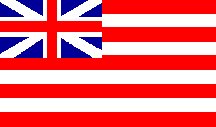
British East India Company
after 1707
|
English East India Company c1600-1707
British East India Company 1707-1800
Using mercenaries to control conquered lands by private companies is not a new practice, and government hiring corporations to control colonies isn't new either. Parliament used the British East India Company to conquer and manage India, and later gave the company trade monopolies in parts of the New World to help pay them. The East India Company was expected to provide the necessary "soldiers for hire" to rule India, and profits made from exporting their Indian tea to the American Colonies helped pay for those soldiers.
The red and white stripes originated in a pattern popular in the Tudor period (1485-1603), and most invariably had the Saint George Cross in the canton. Since the British East India Company didn't seem to actually have any real clear expectations on their flag design, other than using horizontal red and white stripes, we have flags with nine, ten, eleven or even thirteen stripes; with various cantons of varying size, some sitting on stripes and some cutting through the stripes. Also shown in a painting titled "Two Views of an East Indiaman of the Time of King William III" by Isaac Sailmaker (1633-1721), were long narrow flags with five red and white stripes flown from the foremast and mizzen-mast of EEIC ships, which look like an attempt to make a flag halfway between an ordinary flag and a masthead pennant or streamer. One flag expert said, "They seemed to make them up as they went along." This isn't surprising because the flags were usually made by the crews of the ships and they were not terribly fussy about details.
Interestingly enough, although the British East Indies Company didn't trade directly with the North American colonies and their ships were not permitted to fly this ensign north of Saint Helena, there is a 1754 engraving by Thomas Penn showing what appear to be ships off Philadelphia flying the striped flag of 1707. However, noted Flag historian Peter Ansoff discovered that the ships in the engraving were in fact copied from an earlier engraving showing ships at anchor in Bombay harbor. For more information about the EEIC and more of their flags see the English East India Company on the "Flags of Britain and the United Kingdom" page. |
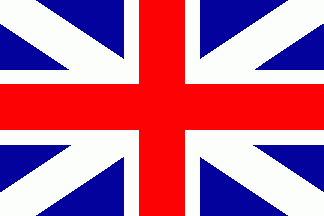
The new "King’s Colors" |
The British Union Flag 1606
With King James I inheritance of the English throne in 1603, the Cross of Saint George was placed over the Scottish Cross of Saint Andrew to form the British Union Flag. Although the traditional St. George's Cross flag continued as the national flag for some years, all seagoing ships began using the Union flag (better known today as the Union Jack). But in 1634, use of the Union Jack was restricted to only the King's Royal Navy ships, and its use by merchant ships was forbidden. The continued use of this flag by merchant ships commissioned by the Royal Governors in the American colonies would cause problems until a solution was found in 1707 (see below)
|
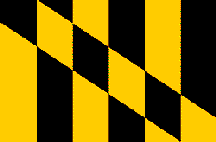
Lord Baltimore Flag
|
Lord Baltimore Flag 1622
The Lord Baltimore flag combines the black and gold family arms of the Lords Baltimore, the colonial proprietors of Maryland, granted to the first Lord Baltimore - George Calvert in 1622.
There is no evidence to indicate how much this flag was actually used to represent Maryland in Colonial times, or in the years leading up to the Revolutionary War. However, its design is used today as a part of the State flag of Maryland. |

The Pine Tree Flag
|
The Pine Tree Flag 1686
The "Pine Tree Flag" is a generic name for a number of flags used in New England from 1686 to 1776. The use of the Pine tree as a symbol was common in colonial times. Legend tells us that the Sons of Liberty would first rally under a Pine tree they called the "Liberty Tree." (The actual Liberty Tree in Boston was an Elm, however, not a Pine)
A white Pine Tree ensign, accompanied by the motto "Appeal to Heaven" became that of the Massachusetts Merchant Navy in 1775, and a year later became the official flag of the short lived Massachusetts Navy which was destroyed by the British at the Battle of Penobscot Bay. The tradition continues today and since 1971, the plain white flag with just the Pine tree has been the official Massachusetts Naval Flag. |
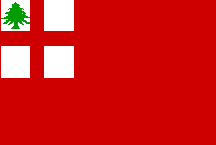
New England Flag
1693-1707 at sea

Red Flag of New England
variant reported in use 1711

Red Flag of New England?
variant reported in use 1693 and 1703
|
The New England Ensign 1686-1707 (at sea)
This flag first appeared in 1686 in a drawing done by a young British officer named John Graydon who painted the picture of the New England Flag in a manuscript, now in the collection of Magdalene College in Cambridge, England. Graydon (born c1663, died c1726) later became an Admiral in His Majesty's Royal Navy and was quite well known in his day. His drawing showed a white flag (not shown) with a red cross and a green tree in the canton. We know a version of this flag with a red field (shown) had some use by Colonial merchant ships sailing out of New England ports as early as 1693, and it was the earliest flag identified with all of New England, although it was flown by mainly by ships from the Massachusetts Bay Colony. This flag later became a frequent navy flag for many New England ships.
The New England Ensign appears on flag charts printed in 1693, 1701, and 1705. However, the New England Flag was also shown on a Dutch flag chart in 1711 as having a globe instead of the tree in the canton. A French flag chart was published in 1693 and reprinted in 1703 shows the Pine Tree, but shows heraldic hatching for a blue field, although describing it as being the "Red Ensign of New England" . The 1711 and 1718 publications also show the heraldic hatching for blue and were likely copied from the 1693 sheet. No English or American source shows a blue field. The appearance on flag charts implies that the New England Ensign was in use as a maritime flag, but according to the Proclamation of 1674, the only legal flag to fly on a colonial ship was the red ensign with the St. George Cross canton. Adding the tree may have happened quite unofficially, but we have no real evidence of this.
This flag may have also been used by some military companies in the Boston area although the color of the field probably would have varied between units. It was used by at least one militia unit in Connecticut in the 1730s. The earliest actual version of this flag still in existance would probably be the Laube Flag, discovered by Gary Laube in an 18th Century trunk from an estate sale in 1992. It would appear that the New England flag was no longer used at sea after 1707 when Queen Anne prescribed that the red ensign would be the only legal flag to be worn by ships of Her Majesty's colonies. Tradition, however, incorrectly says its use on land continued and it was present at the Battle of Bunker Hill. (see False Bunker Hill Flag) |

"New England" Flag 1687
|
Governor Andros' "New England" Flag 1687
Sir Edmund Andros was probably the most hated man in America in 1687 by the residents of Massachusetts Bay and the other colonies that had been attached to the new Dominion (New Hampshire, Connecticut, Rhode Island, New Haven, New York). They had always governed themselves and this new governor and his administration was forced upon them unwillingly. The "New England" flag was probably intended for the colours of the military guard that accompanied Andros.
Apparently two copies of the flag were made for Sir Edmund Andros when he sailed to Boston in 1687 to take control of the new Dominion of New England. They were described as having a pole and fringe (not shown here), so the supposition is that these were used as his body guard's ceremonial colours. The Glorious Revolution of 1688 ended both the Dominion and the rule of Governor Andros a short year later.
|
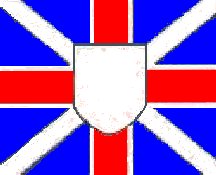
A "Union Flag" for
the North American Colonies?
|
The Colonial Union Jack 1701
In 1701 another variant of the Union Jack was created for the use of ships commissioned by the governors of the North American colonies. It is unknown how much use this variant saw before the introduction of the Colonial Red Ensign by Queen Anne six years later. This variant was the result of Admiralty complains about the continued use of the King's Colors (Union Flag) by merchant ships commissioned by the Royal Governors in the American colonies. To stop this practice the Naval Council ordered the use of a distinctive Union Jack, defaced with a white escutcheon (shield) in its center, for ships commissioned by the governors. (Click Here for more information about this flag)
|
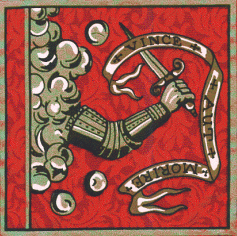
Nathaniel Page's Flag |
The Bedford Flag c1700
The Bedford Flag may be the oldest complete flag known to exist in the United States. Physical and historical evidence dates it from early in the 1700s, and the Bedford Flag is similar to a flag described as having been used by a cavalry troop of the Massachusetts Bay Militia in the French and Indian Wars. It may well have been that flag. Further legend states that it was later carried by Bedford Minuteman, Nathaniel Page, to the Concord Bridge on April 19, 1775, at the beginning of the American Revolution. However, there is no proof, either from testimonies, depositions, diaries or memoirs written by any participants, mentioning any such flag flown that day.
The Latin inscription "Vince Aut Morire" means "conquer or die." The arm emerging from the clouds represents the arm of God. The original is housed at the Bedford, Massachusetts Town Library.
|
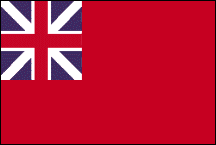
Queen Anne's Flag
|
The Colonial Red Ensign 1707
The British Red Ensign, also known as the "Meteor" Flag, was adopted as the new flag for England and her colonies in 1707 at the request of Queen Anne. Because of this the flag also carries the name "Queen Anne's Flag." This was the first "national flag" to fly over the English American colonies. |
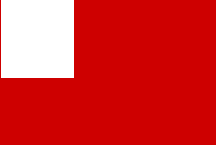
Massachusetts Bay Colony
|
The Massachusetts Bay Colony Flag 1636
After Roger Williams stated the cross was a symbol of the antichrist, John Endicott, a former Governor of Massachusetts Bay Colony, led an attempt to have part of the cross removed from the militia colours of the troops at Salem. The Great and General Court of the Massachusetts Bay Colony found Endicott had "exceeded the lymits of his calling" and punished him by forbidding him to hold public office for one year.
The militia leaders then decided leave out the cross completely in their colours after that incident, at least in Boston and the surrounding communities. There is evidence it was kept in other places in New England. Certainly it was a part of the design of the militia colours in Saybrook, Connecticut and in Newburyport, Massachusetts in this era. |
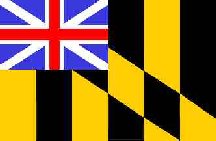
Calvert Colours
|
The Calvert Arms/King's Colors 1754
The Calvert Arms/King's Colors has the antique gold and black diamonds of the Calvert coat-of-arms as the field. The Calverts were the Lord Proprietors of the Royal Colony of Maryland. (This is the same design that is used in two quarters of the current flag of the State of Maryland, the other two quarters use the design of the "Crosslands.")
The Maryland Militia fought under the Calvert Arms in their expedition of 1754 and this may have been the first first British-American flag to go into battle with George Washington. It was certainly used in King Philip's War of 1675 and in the later French and Indian War. |
| Top of Page | The Vikings | The Spanish | The Dutch | The Swedes | The English | The French | The Russians |
The French Explorers and Colonies
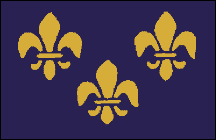
Blue Fleur de Lys of France
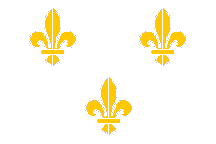
White Fleur de Lys of France
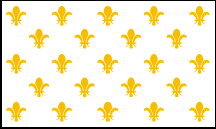
Multiple Fleur de Lys of France
|
Royal Ensigns of France 1590-1790
From 1590-1790 these four flags were used on French warships and fortresses. They were all based on the blue Royal Banner of France used since the 17th century. The blue fleur de Lys flag was gradually replaced by the white fleur de Lys flag until the French Revolution.
It is believed that the white Fleur de Lys flag of France flew over all or most of the French forts and settlements in America.
The multiple fleur de Lys pattern was purchased in large lots and then cut to whatever size was need for a particular flag. Therefore, the number of fleur de Lys on each flag would depended on it's size, and no two had exactly the same number. This flag also came with a blue field background.

Royal Navy's ensign 1638-1790
(not a missing image, but a plain white flag)
Between 1638 and 1790; and from 1814 to 1830, a plain white flag was flown most commonly on French Royal Warships. Obviously, this probably led to some confusion since the international request to "surrender" or "parley" is also a plain white flag.
|
| Top of Page | The Vikings | The Spanish | The Dutch | The Swedes | The English | The French | The Russians |
The Russian Explorers and Colonies
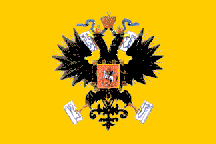
Russian Imperial Standard
|
Personal Standard of the Tsar 1699-1917
There wasn't an official Russian National Flag before 1896, but the Personal Standard of the Tsar, or Imperial Flag, a double-headed golden eagle carrying Saint Vladimir's red coat of arms, on a yellow rectangular field, served the purpose. Russian Navy ships used this standard and an ensign called "The Flag of Russia" to identify their ships. While the American Revolution was taking place on the east coast of North America, peaceful Russian explorers and ships were exploring Alaska and the western coast of North America and establishing trading post. |
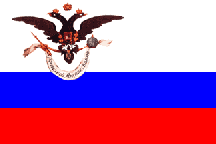
Russian American Company
|
Russian American Company Flag 1799
The Russian-American Company was a trading company chartered by Csar Paul I in 1799. The charter granted the company a monopoly over trade in Russian America. Under the charter, one-third of all profits were to go to the emperor. The Russian-American Company pursued the fur trade in California and in 1812 built a small fort near the Russian River called Ft Ross. Ivan Alexandrovich Kuskov was the founder of Fort Ross and from 1812 to 1821 its colonial administrator. Fort Ross was the southernmost Russian outpost and is now reconstructed as a California State Historical Park. |
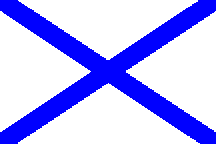
Russian Naval Ensign
|
The Flag of Russia 1812-1841
On September 10, 1812, when Ivan Kuskov established Fort Ross and claimed the Northern "Kalifornii" coast for the Czar, he unfurled this flag of Russia, the light blue Cross of St. Andrew on a field of white. Later Captain John A. Sutter bought Fort Ross on December 12, 1841, for $30,000, mostly in foodstuffs and some gold, and the fort eventually passed into American hands. |
| Top of Page | The Vikings | The Spanish | The Dutch | The Swedes | The English | The French | The Russians |
|